2023 Legal Marketing Technology Ecosystem Study: Emerging Trends and a Breakthrough Metric
By RubyLaw
November 30, 2023 | 7-minute read
Technology Management Communications Software and Platforms
Communications
The 2023 Legal Marketing Technology Ecosystem Study, an annual initiative undertaken by RubyLaw and the Legal Marketing Association (LMA), reveals the critical role of legal marketing technology, the importance of prudent investments and other key insights.
This year’s study explores emerging topics and introduces a breakthrough metric that will add durability, continuity and ongoing impact for years. The 2023 edition includes greater representation from firms below the $100 million revenue threshold, giving rise to more representative and holistic insights into the entire legal sector with a data-backed perspective.
Included in the study is an overview, general observations, category-specific insights and the reveal of adoption ratio, which provides a reliable means for comparison — within this and future studies — and key takeaways:
- Unranked law firms must develop technology-enabled, go-to-market roadmaps or risk losing future upward mobility.
- All firms must continue to invest in content lifecycle management.
Ultimately, effective planning and implementation and smart investments in technology and human capital will dictate the significance of the gaps between the most mature (or ranked) firms and the less mature (or unranked) firms. Those unable to adapt risk becoming irrelevant or insolvent in the long term.
Overview
Nearly 200 respondents ranging from solo marketers to representatives of 25-plus-person teams with technology stacks varying from one to two tools to multiple tools per category participated in the 2023 survey. The participants were asked 29 questions across two sections that inquired about firm revenue, team budget and size, current technology stacks, future technology investments and the systems and tools they use across six technology-related categories and 22 related sub-categories.
Comparing 2023’s results with 2022’s is not an apples-to-apples approach, as respondents are not 1:1. To better interpret both years’ results, we pursued an adoption ratio metric to share the results.
Adoption ratio is the quotient between the normalized reported results of ranked firms and unranked firms about marketing technology, by category. “Ranked” means that a firm was included in either the Am Law 200 or the NLJ 500 and “Unranked” means that a firm was not on either list. Firm rank is important because it is used as a proxy for organizational maturity; the more mature the firm, the likelier it pursues ranking to stand out and the larger its revenues.
The division stage — or separate treatment of the ranked versus unranked responses — was most important. This normalized the responses, giving a forward-looking basis for future comparisons. By viewing ranked and unranked respondents and their respective votes in isolation, we can generate a comparable baseline.
Below, we outline the specific adoption ratios on a category-by-category basis.
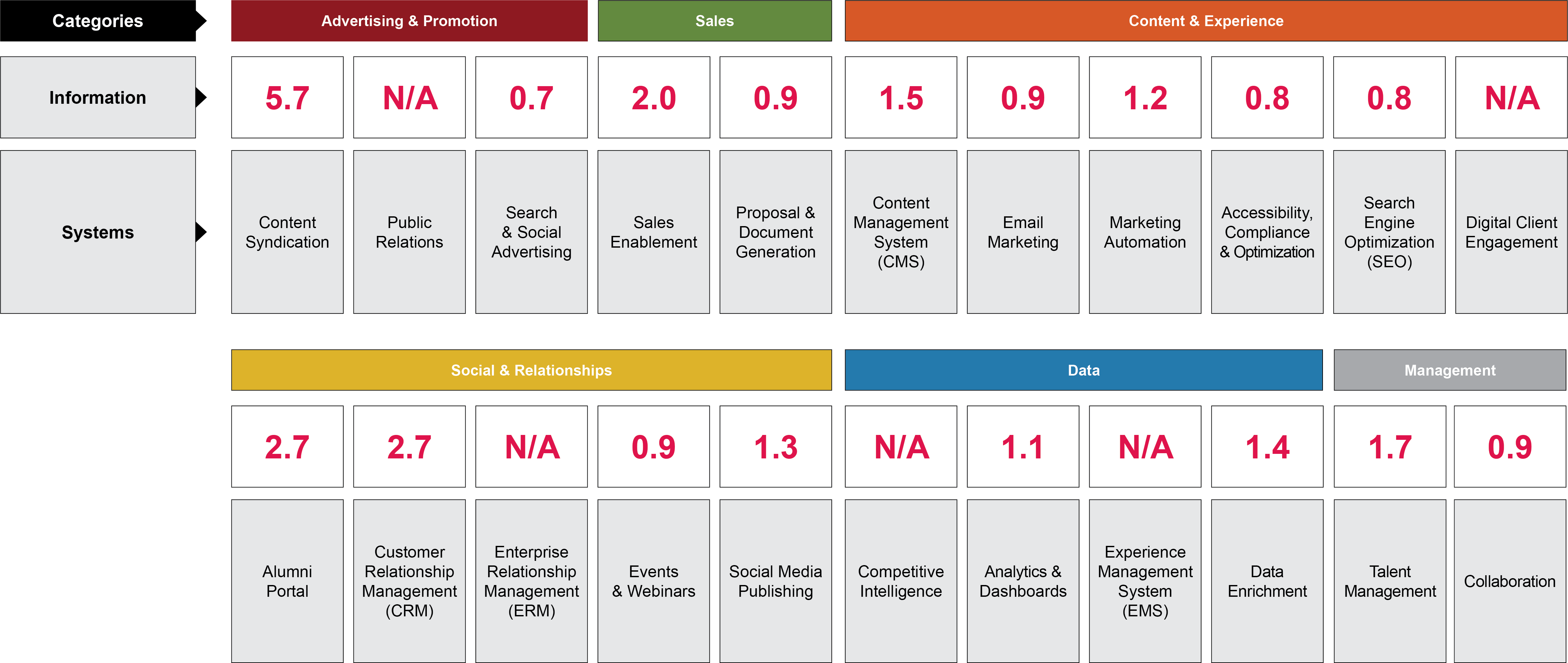
Adoption ratios are rounded to the nearest tenth, from 0.7 up to 5.7.
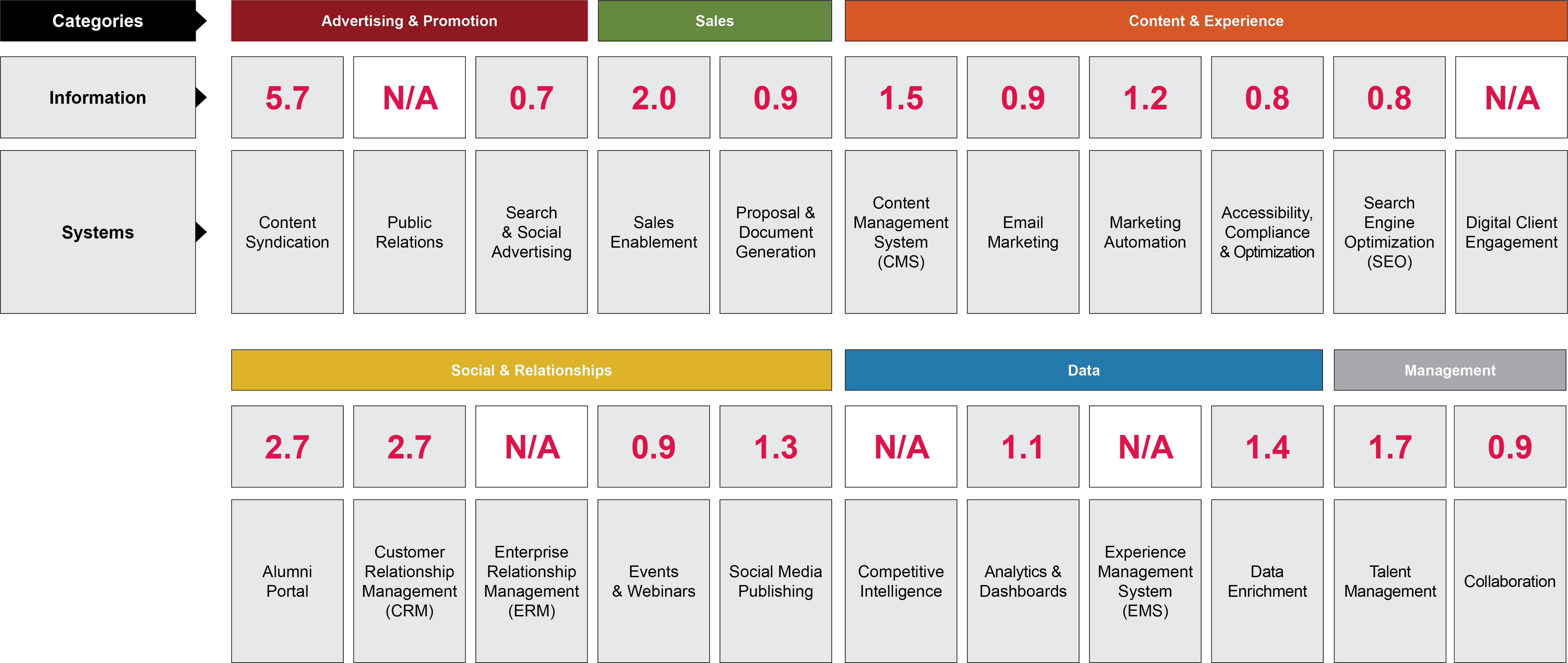 v
v
“N/A” (not applicable) means no respondents from unranked firms reported using tools in that sub-category. When mathematically assessing adoption ratio, a zero as the divisor would yield an error. To maintain the integrity of the metric, we marked these N/A and noted that the disparity between ranked and unranked firms is extraordinary there.
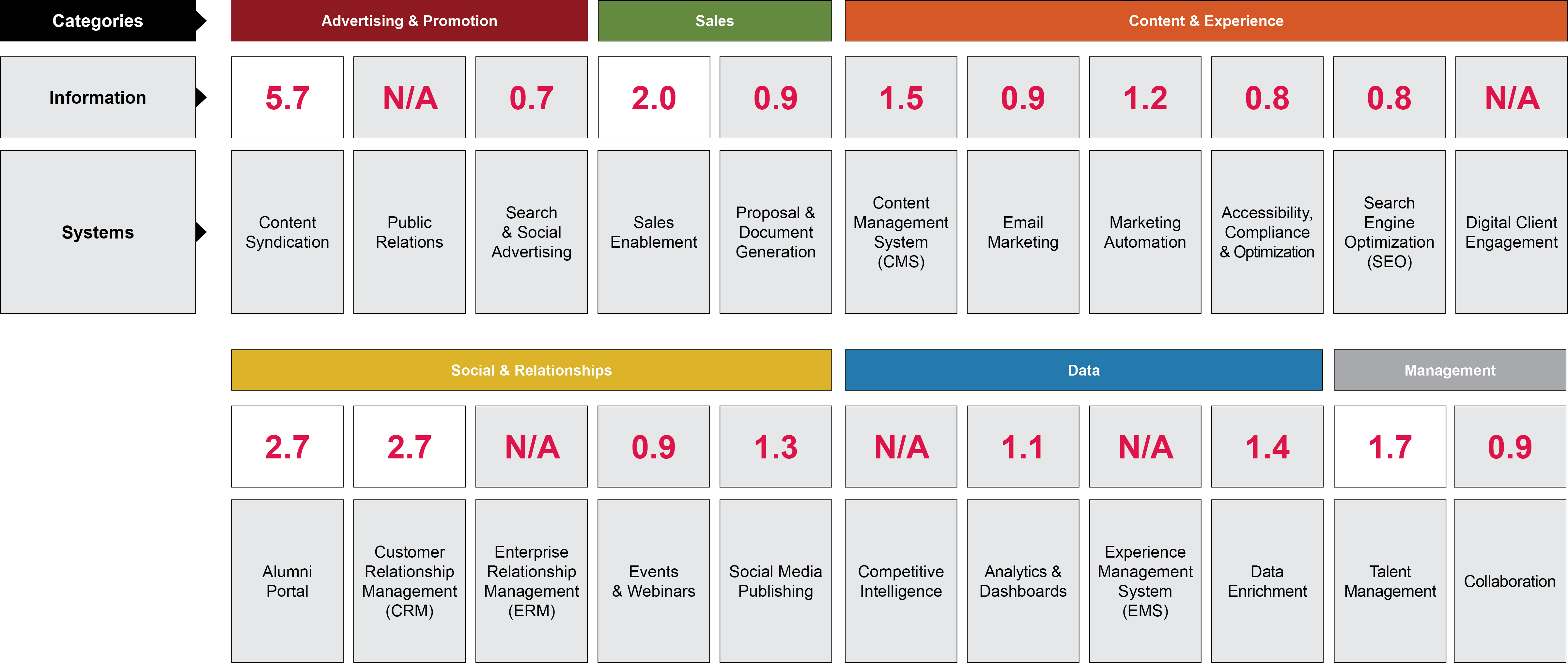
In looking at systems greater than 1.5, the story is similar, but unranked firms do register. Despite a considerable gap, the less mature firms demonstrate utilizing these solutions.
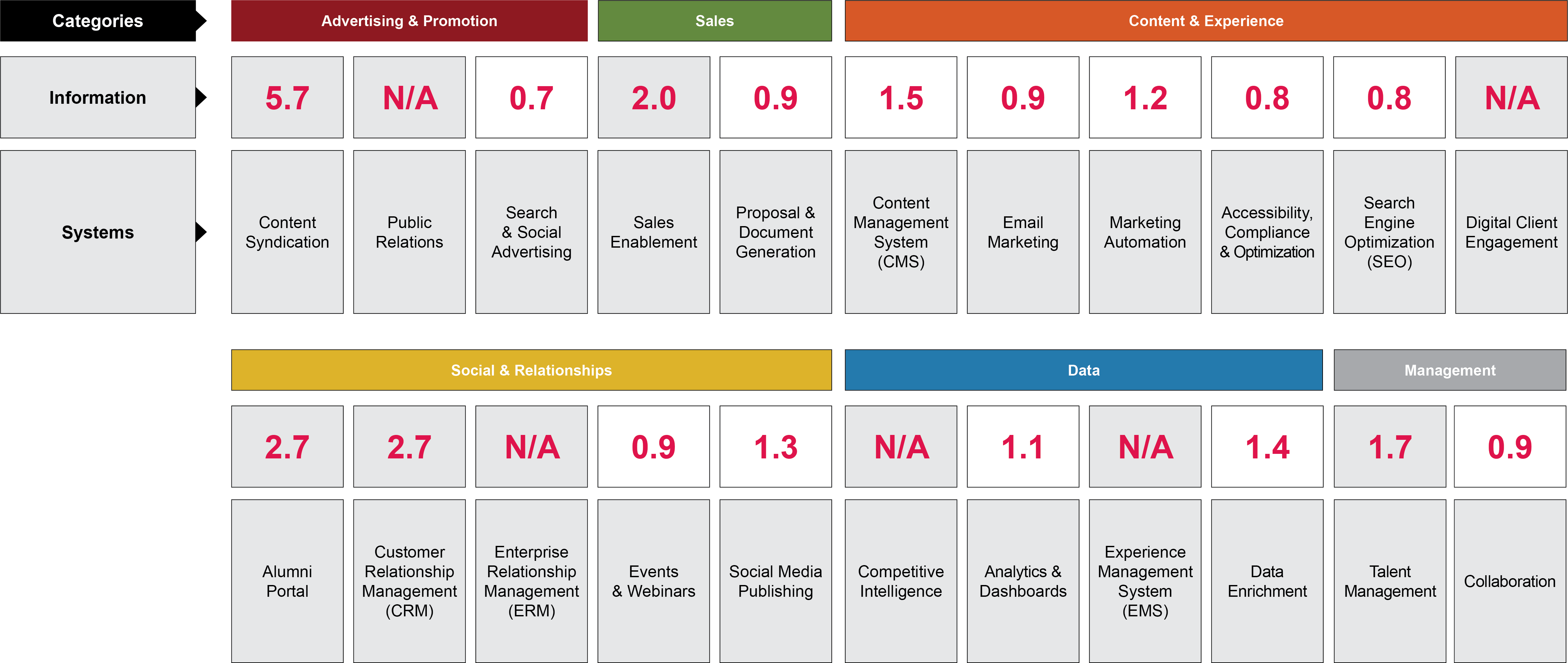
Where numbers hover around 1.0, greater consistency and consolidation around specific systems and tools exists — either in high or low concentrations by firms at both ends, but somewhat uniform.
Why Adoption Ratio Is Important
Adoption ratio indicates the gaps between firms on a system-by-system basis. It also measures where greater alignment between firms happens. Adoption ratio is groundbreaking because it illustrates areas of the technology stack where greater convergence exists.
It is also a barometer of categorical prioritization and preference; we can better understand where firms make marketing technology investments by category and ranking.
Finally, adoption ratio establishes a benchmark measurable in subsequent studies. Because we don’t have a control group, comparing the year-over-year results is more difficult.
Having normalized the data, we can now compare this metric to the 2024 survey results and generate a comparative report.
Key Takeaways
Our key observations from this year’s survey are:
1. Unranked law firms must develop tech-enabled go-to-market roadmaps or risk losing any future upward mobility.
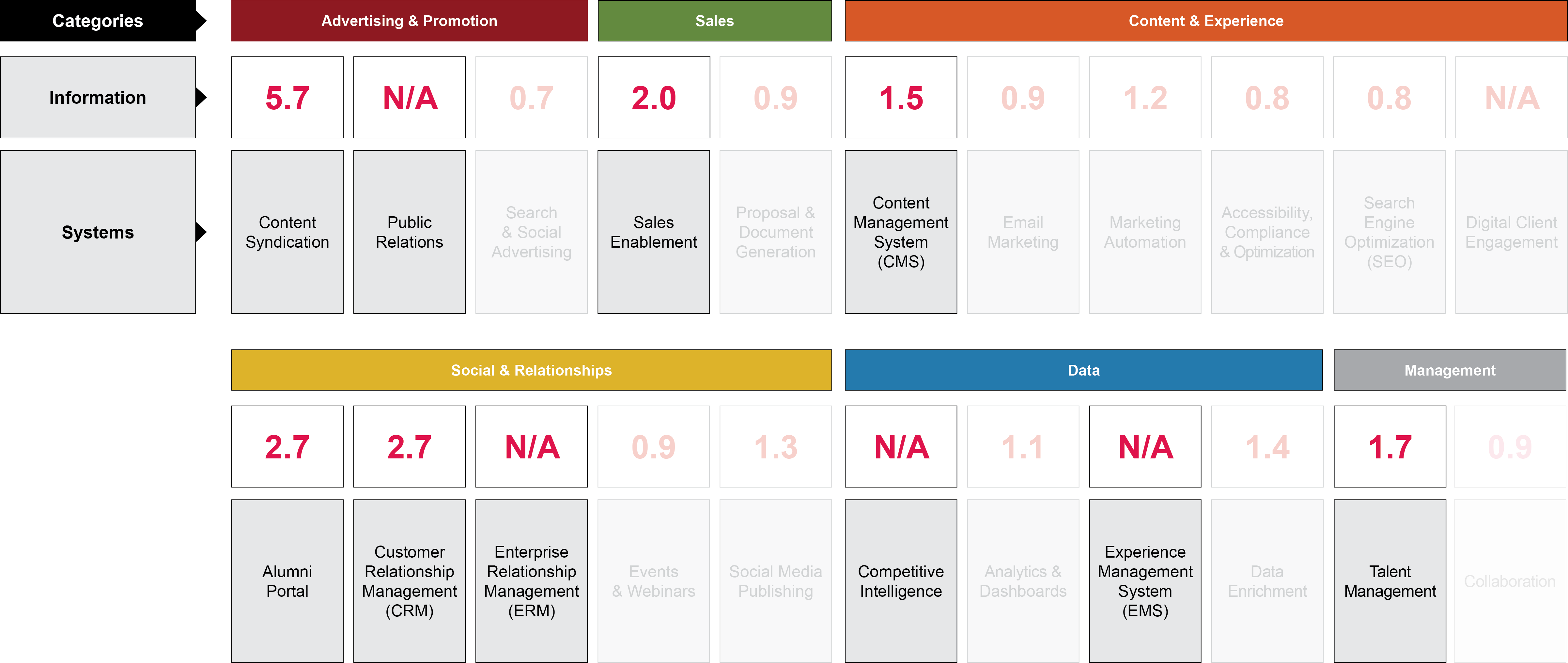
Our observations suggest mature firms are poised to continue widening the gap between themselves and unranked firms; they have more resources and infrastructure to support a denser, interconnected technology stack.
Where the resources are applied is what matters, however. Adoption ratio is a critical metric as it indicates mature firms have invested in tools that support brand awareness, advertising, promotion, sales enablement, key stakeholder relationships, competitive intelligence and recruitment.
Looking at adoption ratio by category, we see the N/A sections — where unranked firms are not registering1 — as well as those where the adoption ratio is 1.5 or higher, indicating a significant gap. This shows ranked firms are well-equipped to support a range of revenue-driving, go-to-market initiatives. This can also translate to an exponential widening of their gap with unranked firms.
This means that unranked firms must “behave in a more evolved manner” by beginning (or continuing) to invest in technology that leads to revenue. No more quick fixes; longer-term, patient approaches must be deliberate. It is therefore recommended that these firms develop a roadmap to identify — and incorporate — tools to support these efforts.
2. All firms must continue to invest in content lifecycle management.
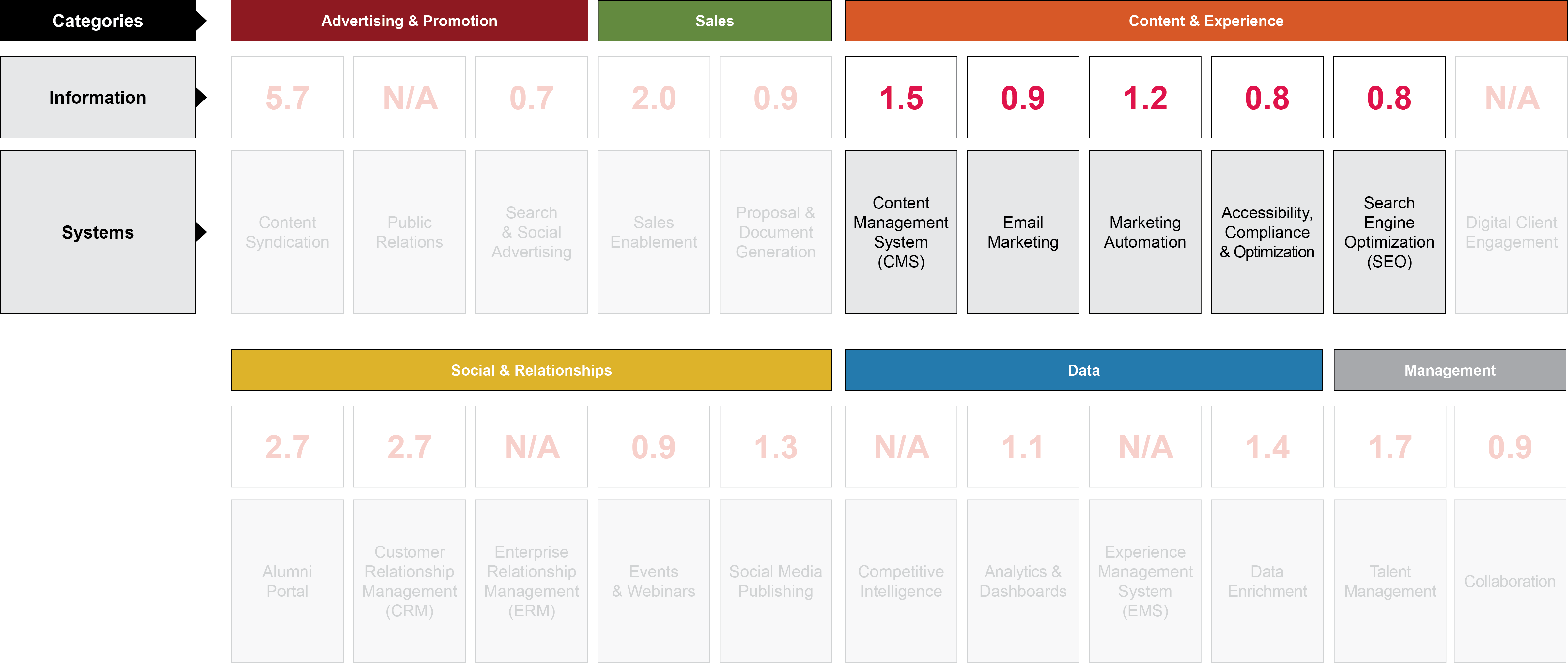
Content lifecycle management (CLM) refers to the collaborative efforts required to draft, edit, manage, publish, revise and unpublish legal marketing content. The data shows all firms must continue to optimize here.
The bulk of CLM-related activities occur in the Content & Experience category, where mature and less mature firms demonstrate the greatest convergence (adoption ratios at or around 1.0). Underscoring the importance of these activities, Content & Experience is the largest category.
Having a suite of tools to ensure content integrity is crucial for firms of all levels. The data indicates consistent investment in technology supporting CLM is worth it. Firms can achieve advantages over competitors by optimizing for the most efficient and highest productivity-yielding solutions in the category. However, strategy and allocation of appropriate human resources and accountability must take priority over technology to ensure its effective utilization.
As a service provider focused on the legal sector, RubyLaw is committed to conducting this important research on an annual basis. While it allows us to further evolve our CLM platform to better meet the changing needs of law firms at all levels, it also serves a higher purpose: to better inform and prepare legal marketers and business developers, and to provide visibility into the at times opaque world of law firm marketing technology. Now, not only do we have greater insight into the tools and systems deployed by law firms, but also a means to visualize law firm tech stacks. With the inclusion of adoption ratio, we can benchmark our findings from year to year. We hope this will catapult the whole sector forward, with law firms serving as beacons for the practice of CLM.
The full 2023 report, which includes additional findings and insights from the survey, is available on the RubyLaw Stack website.
Footnotes
- Please note digital client engagement, which is included under the Content & Experience category, has been grayed out as widespread adoption is not occurring anywhere, including within ranked firms, despite zero unranked firms acknowledging use of the tool. Thus, it was deemed most prudent to discount digital client engagement when considering this takeaway.